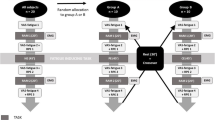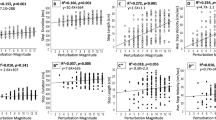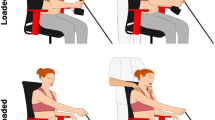Abstract
Arm movements after perturbations like tripping over an obstacle have been suggested to be aspecific startle responses, serve a protective function or contribute to balance recovery. This study aimed at determining if and how arm movements play a functional role in balance recovery after a perturbation. We tripped young subjects using an obstacle that suddenly appeared from the floor at exactly mid-swing. We measured arm muscle EMG, quantified body rotations after tripping, and established the effects of arm movements by calculating how the body would have rotated without arms. Strong asymmetric shoulder muscle responses were observed within 100 ms after trip initiation. Significantly faster and larger responses were found in the contralateral arm abductors on the non-tripped (right) side. Mean amplitudes were larger in the ipsilateral retroflexors and contralateral anteflexors. The resulting asymmetric arm movements had a small effect on body rotation in the sagittal and frontal planes, but substantially affected the body orientation in the transverse plane. With the enlargement of the ongoing arm swing, the arms contributed to balance recovery by postponing the transfer of arm angular momentum to the trunk. This resulted in an axial rotation of the lower segments of the body towards the non-tripped side, which increases the length of the recovery step in the sagittal plane, and therefore facilitates braking the impending fall.







Similar content being viewed by others
References
Allum JH, Carpenter MG, Honegger F, Adkin AL, Bloem BR (2002) Age-dependent variations in the directional sensitivity of balance corrections and compensatory arm movements in man. J Physiol 542:643–663
Bruijn SM, Meijer OG, van Diëen JH, Kingma I, Lamoth CJC (2008) Coordination of leg swing, thorax rotations, and pelvis rotations during gait: The organisation of total body angular momentum. Gait Posture 27:455–462
Cappozzo A, Catani F, Della Croce U, Leardini A (1995) Position and orientation in space of bones during movement: anatomical frame definition and determination. Clin Biomech 10:171
Dietz V, Fouad K, Bastiaanse CM (2001) Neuronal coordination of arm and leg movements during human locomotion. Eur J Neurosci 14:1906–1914
Elftman H (1939) The function of the arms in walking. Hum Biol 11:529–535
Eng JJ, Winter DA, Patla AE (1994) Strategies for recovery from a trip in early and late swing during human walking. Exp Brain Res 102:339–349
Grabiner MD, Koh TJ, Lundin TM, Jahnigen DW (1993) Kinematics of recovery from a stumble. J Gerontol A Biol Sci Med Sci 48:M97–M102
Grabiner MD, Donovan S, Bareither ML, Marone JR, Hamstra-Wright K, Gatts S, Troy KL (2008) Trunk kinematics and fall risk of older adults: translating biomechanical results to the clinic. J Electromyogr Kinesiol 18:197–204
Hof AL (2007) The equations of motion for a standing human reveal three mechanisms for balance. J Biomech 40:451–457
Hof AL, Gazendam MG, Sinke WE (2005) The condition for dynamic stability. J Biomech 38:1–8
Hsiao ET, Robinovitch SN (1997) Common protective movements govern unexpected falls from standing height. J Biomech 31:1–9
Kim BJ, Robinson CJ (2005) Postural control and detection of slip/fall initiation in the elderly population. Ergonomics 48:1065–1085
Kingma I, Toussaint HM, De Looze MP, van Dieën JH (1996) Segment inertial parameter evaluation in two anthropometric models by application of a dynamic linked segment model. J Biomech 29:693–704
Lockhart TE (2008) An integrated approach towards identifying age-related mechanisms of slip initiated falls. J Electromyogr Kinesiol 18:204–217
Maki BE, McIlroy WE (1997) The role of limb movements in maintaining upright stance: the “change-in-support” strategy. Phys Ther 77:488–507
Marigold DS, Bethune AJ, Patla AE (2003) Role of the unperturbed limb and arms in the reactive recovery response to an unexpected slip during locomotion. J Neurophysiol 89:1727–1737
McConville JT, Churchill TD, Kaleps I, Clauser CE, Cuzzi J (1980) Anthropometric relationships of body and body segment moments of inertia. Technical Report. Aerospace Medical Research Laboratory, Ohio
McIlroy WE, Maki BE (1995) Early activation of arm muscles follows external perturbation of upright stance. Neurosci Lett 184:177–180
Misiaszek JE (2003) Early activation of arm and leg muscles following pulls to the waist during walking. Exp Brain Res 151:318–329
Misiaszek JE, Krauss EM (2005) Restricting arm use enhances compensatory reactions of leg muscles during walking. Exp Brain Res 161:474–485
Ortega JD, Fehlman LA, Farley CT (2008) Effects of aging and arm swing on the metabolic cost of stability in human walking. J Biomech 41:3303–3308
Pavol MJ, Owings TM, Foley KT, Grabiner MD (2001) Mechanisms leading to a fall from an induced trip in healthy older adults. J Gerontol A Biol Sci Med Sci 56:M428–M437
Pijnappels M, Bobbert MF, van Dieën JH (2001) Changes in walking pattern caused by the possibility of a tripping reaction. Gait Posture 14:11–18
Pijnappels M, Bobbert MF, van Dieën JH (2004) Contribution of the support limb in control of angular momentum after tripping. J Biomech 37:1811–1818
Pijnappels M, Bobbert MF, van Dieën JH (2005) How early reactions in the support limb contribute to balance recovery after tripping. J Biomech 38:627–634
Roos PE, McGuigan MP, Kerwin DG, Trewartha G (2008) The role of arm movement in early trip recovery in younger and older adults. Gait Posture 27:352–356
Schillings AM, Van Wezel BMH, Mulder T, Duysens J (2000) Muscular responses and movement strategies during stumbling over obstacles. J Neurophysiol 83:2093–2102
Staude G, Wolf W (1999) Objective motor response onset detection in surface myoelectric signals. Med Eng Phys 21:449–467
van der Burg JC, Pijnappels M, van Dieën JH (2005) Out-of-plane trunk movements and trunk muscle activity after a trip during walking. Exp Brain Res 165:407–412
van Dieën JH, Pijnappels M, Bobbert MF (2005) Age-related intrinsic limitations in preventing a trip and regaining balance after a trip. Saf Sci 43:437–453
Young JW, Chandler RF, Snow CC, Robinette KM, Zehner GF, Lofberg MS (1983) Anthropometric and mass distribution characteristics of the adult female. Technical Report, FAA Civil Aeromedical Institute, Oklahoma
Acknowledgments
The authors would like to thank Petra van der Burg and Maarten Bobbert for their contribution to this study and the Netherlands Organisation for Scientific Research (NWO) for their financial support (grant # 916.76.077).
Author information
Authors and Affiliations
Corresponding author
Appendix
Appendix
Equations of motion for armless body
First, the body was separated in two segment sets, arms (two arms) and trunk + legs (trunk plus two legs). For these two segment sets, the equations of motion, with moment equations around the center of mass, are (see Fig. 8):
where g = gravity vector, m = mass, a = acceleration vector, r = position vector, \( {\dot{\mathbf{L}}} \) = rate of change of the angular momentum, x = vector product, F sh and M sh = reaction force and moment at the shoulder, with tr = on the trunk and ua = on the upper arm. Furthermore, F grf = ground reaction force, M grf = ground reaction moment (only non-zero around the vertical axis) and COP = center of pressure. Inserting Eq. 7 into 8 yields:
From the instant of trip initiation onward, we simulated arm removal so that F sh,tr and M sh,tr are zero and Eq. 9 simplifies to:
Theoretically, this equation can be used to achieve our objective, i.e., to calculate the angular displacement of the trunk + legs without arms between trip initiation and recovery foot landing. However, to calculate angular displacement, this equation would require double numerical integration, which strongly amplifies errors, such as the error in r COP during contact of the tripped foot with the obstacle. We therefore introduced an alternative solution. As M sh,tr = −M sh,ua, and F sh,tr = −F sh,ua, Eq. 6 can be used to rewrite Eq. 9 to:
which can be simplified to:
Now Eq. 10 can be used to replace the right terms in Eq. 12 by \( {\dot{\mathbf{L}}}_{{{\text{trunklegs}}\_{\text{armless}}}} \):
which can be rearranged using Eq. 5 and F sh,tr = −F sh,ua:
Now the angular momentum L trunklegs_armless at the time range from trip to recovery foot landing can be calculated by integrating Eq. 14:
Note that the integral term on the right is only non-zero between trip initiation and liftoff of the non-tripped leg. This is not the case for and L arms and L trunklegs, which are non-zero at the initiation of the trip so that:
Importantly, L arms and L trunklegs can be calculated directly from the kinematics using Eq. 1 rather than by using Eq. 16. Therefore, only the rightmost term in Eq. 15 requires integration, so that application of Eq. 15 is more robust than application of Eq. 10, in that the effect of the r COP error during contact with the obstacle, as outlined before, is smaller than in Eq. 10.
As can be seen from Eq. 16, Eq. 15 takes into account the angular momentum of the arms and trunk + legs at the instant of trip as well. Effectively, application of Eq. 15 therefore means that, at the instant of tripping, L arms is transferred to the trunk + legs, prior to ‘cutting away’ the arms. We will further denote this as the ‘transfer&cut’ condition. This transfer of L arms can have substantial effects. In normal gait, the arm swing causes substantial angular momentum in the arms, the direction of which is reversed at each step by exchange of angular momentum with the rest of the body (Bruijn et al. 2008). At mid-swing, i.e., at the instant our subjects were tripped, the angular momentum of the arms reaches a maximum.
To establish the effect of the transfer of the angular momentum of the arms in the ‘transfer&cut’ condition, we performed an alternative calculation. In this condition, we ignored the angular momentum of the arms at the instant of tripping:
This calculation, to be further denoted as ‘cut’ condition, effectively simulates that the arms would be cut off at the instant of tripping, but would keep on rotating, i.e., would keep their own angular momentum rather than transferring it to the trunk + legs segment.
Rights and permissions
About this article
Cite this article
Pijnappels, M., Kingma, I., Wezenberg, D. et al. Armed against falls: the contribution of arm movements to balance recovery after tripping. Exp Brain Res 201, 689–699 (2010). https://doi.org/10.1007/s00221-009-2088-7
Received:
Accepted:
Published:
Issue Date:
DOI: https://doi.org/10.1007/s00221-009-2088-7





